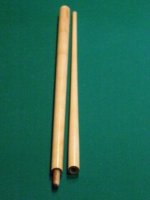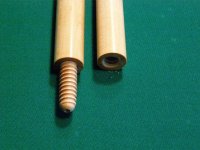Just wondering if there are any methods on reinforcing the joint on a Sneaky Pete without using joint collars.
You are using an out of date browser. It may not display this or other websites correctly.
You should upgrade or use an alternative browser.
You should upgrade or use an alternative browser.
Sneaky Pete without collars.....
- Thread starter Onepocketking1
- Start date
Just wondering if there are any methods on reinforcing the joint on a Sneaky Pete without using joint collars.
The best thing is to use a pin like a 3/8 x 10 or radial. They require the smallest drilled hole and retain the most side wall to the joint. If you use say a 5/16 x 14 you have to drill a much larger hole to accommodate the insert. Also, don't drill any deeper then you have to and when installing the screw he aware of a pressure blowout that can crack the joint. The glue will act as a hydraulic and create a lot of force so use a very minimal amount of glue with the screw. Even if you don't see it at first you still may have cracked it and it will show up later so be careful. It is good to grind a small flat on the side of the screw as a relief for the glue. The dried glue in the slot will also act as a shear key to lock in the screw.
Eric Wynne
Banned
Thin CA glue , if knowledgeable , makes a good finish ...
You can use a phenolic plug in the front of butt and in the shaft. it will add a touch of weight to the front end but it will reinforce both the butt and shaft.
The best thing is to use a pin like a 3/8 x 10 or radial. They require the smallest drilled hole and retain the most side wall to the joint. If you use say a 5/16 x 14 you have to drill a much larger hole to accommodate the insert. Also, don't drill any deeper then you have to and when installing the screw he aware of a pressure blowout that can crack the joint. The glue will act as a hydraulic and create a lot of force so use a very minimal amount of glue with the screw. Even if you don't see it at first you still may have cracked it and it will show up later so be careful. It is good to grind a small flat on the side of the screw as a relief for the glue. The dried glue in the slot will also act as a shear key to lock in the screw.
Hi,
3/8 is .375 and is bigger than 5/16 which is .3125. I think you meant to say the 5/16 pin gives you a thicker wall at the joint.
I agree with you logic about the wall thickness being the important factor.
Rick G
Hi,
3/8 is .375 and is bigger than 5/16 which is .3125. I think you meant to say the 5/16 pin gives you a thicker wall at the joint.
I agree with you logic about the wall thickness being the important factor.
Rick G
Maybe I'm misunderstanding, but I think he was referring to the shaft side which is usually the one the splits most often when no collar is used.If a stock 5/16 brass insert is used in the shaft, then It requires a 7/16 tap to fit the OD threads, if It's a self centering insert,then Your looking at a shoulder that is somewhere in the range of .450 I believe.
Greg
Hi,
3/8 is .375 and is bigger than 5/16 which is .3125. I think you meant to say the 5/16 pin gives you a thicker wall at the joint.
I agree with you logic about the wall thickness being the important factor.
Rick G
No, he was saying the wall was thinner on the shaft side of the joint in the 5/16 pin because of the 7/16 brass insert. Although that is correct, the brass insert being epoxied in is stronger as it keeps the wood from splitting so easily. I found out real fast many years ago making conversions without rings is not best. And making conversions without rings our a insert is even worse.
The angle on the thread works just about like a splitting maul. If someone leaves the cue slightly loose on a wood thread joint with no collar and hits a ball with it, the angle of the thread can often split the side of the shaft out. It can happen with the insert also, but I have seen many more with no insert and no collar rings split than any other combination.
No, he was saying the wall was thinner on the shaft side of the joint in the 5/16 pin because of the 7/16 brass insert. Although that is correct, the brass insert being epoxied in is stronger as it keeps the wood from splitting so easily. I found out real fast many years ago making conversions without rings is not best. And making conversions without rings our a insert is even worse.
The angle on the thread works just about like a splitting maul. If someone leaves the cue slightly loose on a wood thread joint with no collar and hits a ball with it, the angle of the thread can often split the side of the shaft out. It can happen with the insert also, but I have seen many more with no insert and no collar rings split than any other combination.
Hi,
That makes sense to me Chris. A guy wanted me to make a SP for him last month without a joint collar. I said no because I only use one pin on my cues and I was afraid of the wood splitting. He went with the joint collar and we were both happy in the end.
Rick
Hi,
3/8 is .375 and is bigger than 5/16 which is .3125. I think you meant to say the 5/16 pin gives you a thicker wall at the joint.
I agree with you logic about the wall thickness being the important factor.
Rick G
No, that was what I meant. My point was the size of the hole you need to drill in the shaft to accommodate the brass insert. The 3/8 10 screw requires a smaller hole around 9/32 (not the 5/16 called for in most machine manuals for a machine screw that many cue guys drill), compared to a 27/64 requited for most inserts. The worry is the shaft splitting along the grain with no reinforcement also as you move to the shaft the cue is getting smaller. With an insert it leaves a pretty thin side wall depending on what the joint dimensions are.. I have seen a lot of shafts split at the joint on SP's regardless of the type of joint without collars.
Hi,
That makes sense to me Chris. A guy wanted me to make a SP for him last month without a joint collar. I said no because I only use one pin on my cues and I was afraid of the wood splitting. He went with the joint collar and we were both happy in the end.
Rick
I used to sell the McDermott SP years ago in my pool room and they were my biggest seller. They were like $50.00 at that time. Then they just stopped making them. When I called the company about not being able to get them anymore they told me too may split and being a reputable company they would replace the cue no questions asked. But it was just happening to much so they took the cue out of their line. For the most part it is fine and many have been out there for years with no problems but I prefer a collar on the shaft side at least. It looks nice as well and it is not like someone is fooling people into thinking it is a one piece house cue or something.
I have seen them split first hand. A guy misses a shot and whips the cue and you hear that sound of the cracking. It don't take much, there is a lot of leverage in the length of the shaft.
Last edited:
Adding a brass insert and when inserting the insert, using
a CA or resin with a flexible agent will work best to provide stability in the shaft and at the same time giving resiliency and strength. Good Luck.
Mike
acedonkeyace:smile::thumbup:
a CA or resin with a flexible agent will work best to provide stability in the shaft and at the same time giving resiliency and strength. Good Luck.
Mike
acedonkeyace:smile::thumbup:
no collar 1/2 inch wood pin
at this time i will not sell any of these cues because i can't guarantee them, but i have one i have been using for about a year as my player and it has no collar on the butt or shaft, it has a 1/2 by 8 wood pin. i have to drill a .42 inch hole into the shaft before i cut the threads, the cue is .86 at the joint so this leaves me with about .22 side thickness. after the threads are cue i treat the wood with a hardner, then recut the threads. might not be for everyone but i like it.
cue was made from an american classic billiard one piece cue. its a full splice straight grain maple into straight grain maple, maple pin and maple shaft.
at this time i will not sell any of these cues because i can't guarantee them, but i have one i have been using for about a year as my player and it has no collar on the butt or shaft, it has a 1/2 by 8 wood pin. i have to drill a .42 inch hole into the shaft before i cut the threads, the cue is .86 at the joint so this leaves me with about .22 side thickness. after the threads are cue i treat the wood with a hardner, then recut the threads. might not be for everyone but i like it.
cue was made from an american classic billiard one piece cue. its a full splice straight grain maple into straight grain maple, maple pin and maple shaft.
Attachments
my humble opinion
I have made many sneakies out of house cues with 5/16x18 and 14 pin/insert and NEVER had one to bust or crack but I have only made a few with 3/8x10 and they both busted!!!!personally I hate the big pins but so many like them sooooooo......Just wondering if there are any methods on reinforcing the joint on a Sneaky Pete without using joint collars.

